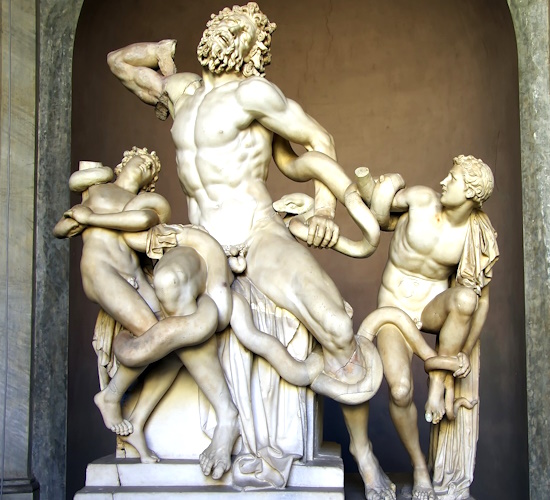The sculpture of Laocoon and his sons (Laocoon Group), housed in the Pio Clementine Museum in the Vatican Museums, represents a moving moment from Greek mythology and is considered an example of classical art. During your trip to the Vatican Museums, the Laocoon group can expect a deep insight into the artistry and emotional intensity of ancient sculptures.
Buy skip-the-line tickets to the Vatican Museum online: Click here

Classification and description:
The Laocoon group dates back to the Hellenistic period and dates back to the early 1st century BC. BC. This sculpture depicts a tragic scene from the Trojan War in which the hero fights a sea serpent sent by the gods in return for exposing the Trojans’ tricks.
Discovery and Renaissance:
In 1506, this magnificent masterpiece Laocoon Group was rediscovered in the Vatican Gardens in Rome and captured the imagination of Renaissance artists and scholars. Michelangelo was particularly impressed by the painting’s realistic depiction of suffering and later found it an inspiration for his own works.
Art:
The Laocoon Group is famous for its incredible anatomical accuracy and emotional intensity expressed in the figures’ faces. Intricate details, including twisted muscles and tense facial expressions, elevate these sculptures to the pinnacle of ancient art.
Our tip vatican Museums: Buy tickets without queuingIn theory you can buy an entry ticket at the Vatican Museum, but you usually have to wait in line for hours. The queue along the wall around the Vatican is often several hundred meters long, often even a kilometer or more. Many museum visitors now have tickets with priority entry (tickets without queuing). These are available for pre-sale online. ===>>>> Get tickets to the Vatican Museum here Note: Sometimes tickets are slightly cheaper on this website. The combination ticket for the Vatican with museum and St. Peter’s Basilica is also very popular. St. Peter’s Basilica is theoretically free, but there are also very long queues here. We waited for 2 hours even in December. ===>>>> Here you can get combination tickets for the Vatican Museum and St. Peter’s Basilica |
|
Interpretation Laocoon group:
Discover Laocoon’s symbolism of the eternal struggle between man and fate. Some interpret it as a cautionary tale about the consequences of questioning the will of God, while others see it as a metaphor for the inevitable suffering inherent in the human condition.
The Laocoon group in the Vatican Museum:
Located in the Pio Clementino Museum section of the Vatican Museum, Laocoön is surrounded by a collection of classical sculptures that tell a contextual story about ancient art. Explore the surrounding exhibits to gain a comprehensive understanding of the artistic and historical environment.
—>>>> Combined tickets for the Vatican Museum and St. Peter’s Basilica are available here
Video 4 min (youtube) about the sculpture
Visitor tips:
To fully enjoy Laocoon, take your time and observe the sculpture’s intricate details and nuances.
To gain further insight into the historical and artistic significance of Laocoon, consider taking a guided tour.
Stand before Laocoon and his sons and let the sculpted stories of pain and timelessness transport you to a time when art transcended time and told stories that continue to resonate in the human experience.
The Laocoon group is one of the most important sculptures in the history of art.
All our articles on the Vatican Museums:
Vatican Museums Overview
Pinacoteca of the Vatican
The Sistine Chapel
The Creation of Adam fresco
The Last Judgement
Rooms of Raphael
Pio Clementino Museum
The Torso from the Belvedere
Laocoon
The Gallery of Maps
The Carriage Museum of the Vatican
Who is Laocoon?
Laocoon is a character from Greek mythology who is best known for his tragic story involving snakes. The most famous depiction of the Laocoon episode is the ancient sculpture “Laocoon and His Sons,” now on display in the Vatican Museums in Rome.
According to myth, Laocoon was a Trojan priest of Apollo during the Trojan War. In one version of the story, he tried to warn the Trojans about the dangers of the wooden horse that the Greeks had left outside the city. Laocoon famously said, “Beware of the Greeks who bring gifts.” But the gods punished him for his actions.
In the most popular myth, Laocoon and his two sons were attacked by sea serpents sent by the gods (some accounts speak of Poseidon). The snakes entangled Laocoon and his sons and resulted in their deaths.
The sculpture “Laocoon and his Sons”, the work of three sculptors from Rhodes during the Hellenistic period, is a masterpiece that expresses the torment and despair of the Trojan priest and his sons fighting a snake. These sculptures are known for their emotional intensity and skillful depiction of human suffering.